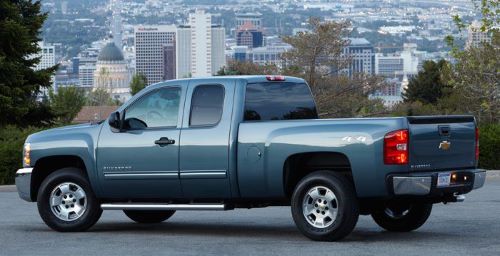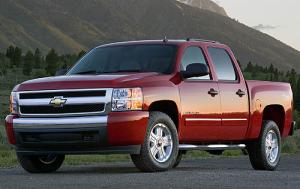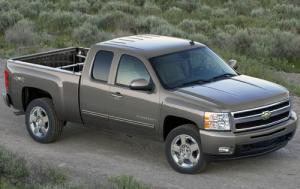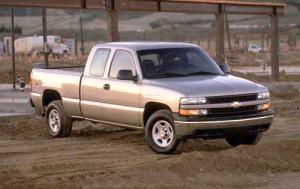
The Chevy Silverado has been a well-regarded pickup for over two decades now. And due to today's high-priced used car market, many shoppers are looking for "older" models that have aged well as a way to save significant dollars.
And by "older", I am generally referring to 10+ year-old vehicles, so those produced in the Silverado's first and second generations, which covered the 1999 - 2013 model years.
But clearly, prospective buyers must weigh the benefits of affordability and performance against potential drawbacks, such as higher maintenance needs and outdated technologies.
So here, ...
- First, we'll look at what history has proven about the reliability of first and second generation Silverado models (again, 1999 - 2013).
Then we'll do an overview of both generation's features and characteristics so potential buyers can get to know the vehicle better.
- We'll then list each generation's possible mechanical issues as reported by owners so they can be checked before buying one today.
- Then we'll review the overall pros and cons of buying an older Silverado in today's high-priced market.
- And then we'll follow that with "Things To Do When Considering An Older Silverado".
1999 - 2013 Chevy Silverado Reliability
First Generation (1999 - 2006):
The first generation Chevy Silverado is generally regarded as a reliable truck, especially when properly maintained. Many owners have reported high mileage with relatively few issues, which speaks to the durability of these trucks. However, like any vehicle, it has also had its share of common problems (detailed later).
Owners often praise the 1st-gen Silverado for its robust build and longevity. Despite the noted issues below, many report that the truck remains reliable for up to hundreds of thousands of miles with proper care.
Second Generation (2007-2013):
The 2nd-gen Silverado is also considered a reliable vehicle, but it comes with its own set of common mechanical issues, as detailed below. Improvements in design and technology over the first generation contributed to this reputation, but some problems persisted or evolved.
Owners of this generation often highlight its improved ride quality, comfort, and technological advancements over the first generation. And despite its mechanical issues, the truck is generally viewed as reliable, especially for those who stay on top of maintenance and repairs.
Overall:
Both generations of the Chevy Silverado are respected for their reliability, with many trucks remaining on the road for well over 200,000 miles. However, prospective buyers should be aware of the common issues associated with each generation and consider these factors when purchasing or maintaining one.
Regular maintenance and timely repairs are crucial to ensuring the longevity and reliability of these trucks, and these are the vehicles a buyer should identify before buying today.
Second Generation (2007 - 2013) Chevy Silverado Overview

With a wide variety of body styles, trim models and powertrains, this version is a very flexible pickup truck that can meet many family driving needs, transport cargo around town, or tow your boat for fun weekend excursions.
Actually, even if you want something sporty, the SS model ... complete with bucket seats, a powerful V8 engine, and upgraded wheels ... may just fit the bill.
This Silverado has also long been praised for its strong work ethic as well as its quiet and comfortable drive. While most were outfitted with a V8 engine (running from 255 horsepower to 345 hp, depending on the engine size ... from 4.8-liter to 6.0-liter), some can be found with the smaller V6.
Competing against the likes of the Ford F150 and Toyota Tundra, this generation received a refreshed look, more power, and additional features over its predecessor.
As in the first generation, it continued to be offered in regular, extended, and crew cab body styles. The extended-cabs have rear-hinged back doors that do not open independently of the front doors, but they do open wider than the previous generation.
The extended and crew cab models feature a three-person rear bench seat and a choice of bucket seats or a bench in front. Regular cabs are front bench seat only.
All of these Silverados outfitted with the V8 engine got a power boost. Some of the 5.3-liter V8s are also flex-fuel (they can run on E85, a blend of ethanol and gasoline). The 5.3 and 6.0-liter engines are also equipped with GM's Active Fuel Management cylinder deactivation. An automatic transmission became a standard feature and an optional manual shift was no longer available.

Rear-wheel drive is also standard, while there are two four-wheel-drive systems. All of these newer Silverados also feature antilock brakes (ABS) and GM's OnStar assistance.
It should also be noted that a 6.2-liter V8 engine as well as a 6-speed automatic transmission were both introduced for the 2009 model year.
These older Silverado models can also be found, depending on the options originally selected, with curtain side airbags, traction and antiskid control, rollover sensors, a power-sliding rear window, navigation, rear-obstacle detection, remote engine start, power-adjustable pedals, and rear power side windows in extended cab models.
And for buyers looking for the more heavy-duty Silverado 2500 or 3500, there's also a 6.6-liter turbodiesel V8 or an 8.1-liter gasoline V8.
Second Generation Chevy Silverado Possible Mechanical Problems
Overall, while the 2nd-gen Silverado is generally regarded as a reliable and versatile truck, the following are mechanical problems that have been reported by some owners which should therefore be included in an inspection before buying:
Transmission Problems: The 4L60E automatic transmission has been reported by some owners to have issues such as slipping, hard shifting, and failure, often occurring around 100,000 to 150,000 miles. Regular maintenance and fluid changes can help mitigate some transmission issues.
Torque Converter Failures: Torque converter shudder and failure were also reported by some owners, leading to poor performance and potential transmission damage if not addressed.
Engine Issues: Some owners have reported intake manifold gasket leaks, especially in V6 but also some V8 engines, leading to coolant mixing with oil.
Fuel System Failures: Fuel pump failures weren't uncommon, requiring costly repairs due to the need to drop the fuel tank.
You May Also Like:
Is It A Good Time To Buy A Car?
Best Time To Buy And How To Negotiate
Electrical Problems: Instrument cluster failures and faulty knock sensors were reported by some owners.
Steering and Suspension: Clunking noise in the steering column, often due to the intermediate steering shaft. Premature wear of ball joints, affecting alignment and tire wear have also been reported.
Rust: Older Silverados have also been prone to rust, particularly in regions with harsh winters and road salt, affecting the frame, undercarriage, and wheel wells.
Radiator Leaks: Radiator leaks and coolant loss were issues on some models, potentially leading to overheating if not addressed.
ABS Module Failures: Issues with the ABS module and wheel speed sensors were reported, resulting in ABS warning lights and potential loss of ABS functionality.
Brake Line Corrosion: Particularly in regions with harsh winters, brake line corrosion was a reported problem, leading to brake fluid leaks and potential brake failure.
Blower Motor Resistor: Failures in the blower motor resistor could cause the HVAC fan to stop working on certain speed settings.
Evaporative Emission Control (EVAP) System Problems: Faults in the EVAP system, including issues with the purge valve and vent valve, could cause check engine lights and emissions-related problems.
First Generation (1999 - 2006) Chevy Silverado Overview

The first generation Silverado is also still fairly well represented in the second-hand market. In addition to its attractive styling, a whole new group of V8 engines were introduced at that time. Power ranged from 255 horsepower in the smallest 4.8-liter engine up to 345 horsepower in the 6.0-liter V8 found in the Silverado SS.
While some Silverados from this production run can also be found with the base V6 engine, most were outfitted with a V8. In addition, a new four-wheel-steering option, QuadraSteer, made its debut about halfway through this generation in some Silverados. This is significant because this system reduced the truck's turning radius to 37.4 feet, approximately 10 feet less than the average full-size pickup.
QuadraSteer was discontinued for 2006, however, as few buyers had opted for it due to is fairly high cost. So this can be a bit hard to find in today's market.
And for heavy-duty Silverado shoppers, this generation also offered the Silverado 2500HD and 3500 with a 6.6-liter turbodiesel V8 or an 8.1-liter gasoline V8.
First Generation Chevy Silverado Possible Mechanical Problems
While the 1st generation Silverado is generally regarded as a durable and reliable truck, these more common mechanical issues, as reported by some owners, should be included in an inspection prior to purchase:
Transmission Issues: Some owners reported that the automatic transmission, particularly the 4L60E, had problems, included slipping, hard shifting, and complete transmission failure. These issues often arose around 100,000 to 150,000 miles.
Torque Converter Problems: Some owners reported issues with the torque converter, which could lead to shuddering and poor performance.
Intake Manifold Gasket Leaks: Some owners reported that the V6 and some V8 engines experienced intake manifold gasket leaks, which could cause coolant to mix with oil, leading to engine damage if not addressed.
Fuel Pump Failures: The fuel pump was a somewhat more common failure point. Symptoms included difficulty starting the vehicle, engine stalling, and loss of power. Replacing the fuel pump often required dropping the fuel tank, adding to repair costs.
Instrument Cluster Failures: Some owners experienced issues with the instrument cluster, including erratic or non-functional gauges. This often required replacing the entire cluster.
Steering Shaft Clunk: A clunking noise in the steering column was reported by some owners and often required replacing or lubricating the intermediate steering shaft.
Ball Joint Wear: Premature wear of the upper and lower ball joints was a known issue, leading to alignment problems and uneven tire wear.
Radiator Leaks: Radiator leaks were relatively common, particularly at higher mileage, leading to overheating issues.
Water Pump Failures: Some owners reported water pump failures, which could cause coolant leaks and overheating.
ABS Module Failures: The ABS module and wheel speed sensors were prone to failure, leading to ABS warning lights and potential loss of ABS functionality.
Brake Line Corrosion: In regions with harsh winters, brake line corrosion was reported by some owners, leading to brake fluid leaks and potential brake failure.
Rust: Rust has been a more pervasive issue, especially in the frame, undercarriage, and wheel wells.
Door Handles and Hinges: Door handles and hinges were known to wear out, leading to difficulty in opening and closing the doors.
Blower Motor Resistor: Some owners experienced failures with the blower motor resistor, affecting the HVAC fan. In addition, issues with the blend door actuators could lead to problems with cabin temperature control.
Pros And Cons of Buying an Older Chevy Silverado Today
Chevy Silverado Pros:
Lower Purchase Price: Significantly cheaper than late model trucks, allowing for substantial upfront savings.
Depreciation: Older models depreciate slower, meaning a buyer might retain more value over time, lowering the overall cost of ownership.
Proven Reliability: Despite some issues, both generations have reputations for durability with proper maintenance, with many remaining on the road for well over 200,000 miles.. In addition, many issues are well-documented, making them easier and often cheaper to diagnose and repair.
Availability of Parts: Parts for these models are widely available and often cheaper than parts for newer vehicles. There's also plenty of aftermarket support and knowledge base for DIY repairs.
Simplicity: Older Silverado models have less complex electronics and systems, making them easier to work on for DIY enthusiasts. Fewer advanced systems mean fewer potential points of failure.
Versatility and Capability: Both generations offer strong towing and hauling capabilities, suitable for a variety of tasks. They are also available in various configurations (Regular, Extended, Crew Cab; different bed lengths) to suit different needs.
Engine Options and Performance: There's a wide range of engine choices, including V6 and V8 options, providing a good balance of power and fuel efficiency. The 5.3L V8 engine is particularly praised for its power and reliability. Some models offer the more powerful 6.2L V8 engine, which is excellent for towing and heavy-duty tasks.
Towing and Hauling Capabilities: Strong towing capacity, making it suitable for hauling trailers, boats, and heavy loads. The Silverado 1500 can tow up to around 10,700 pounds when properly equipped.
Ride Quality and Comfort: The 2nd-gen's improved suspension system provides a smoother and more comfortable ride, also offering a quiet cabin with reduced road and wind noise.
Interior Features and Space: Spacious and well-designed interior with user-friendly controls. Higher trim levels come with luxurious features such as leather seats, advanced infotainment systems, and premium audio systems. Crew Cab models provide ample rear-seat legroom, making it a practical choice for families.
Safety: High safety ratings from organizations like the National Highway Traffic Safety Administration (NHTSA). Features like stability control, antilock brakes, and multiple airbags contribute to overall safety.
Chevy Silverado Cons:
Potential for Higher Maintenance Costs: Older vehicles generally require more frequent maintenance and repairs as components wear out, potentially offsetting some or all of the upfront savings.
Fuel Economy: Fuel economy is relatively low, especially with the larger V8 engines, and also as compared to more efficient newer trucks.
Outdated Technology and Safety Features: Lack of modern infotainment systems, navigation, and advanced driver assistance features found in newer vehicles. Newer safety technologies like backup cameras, lane departure warnings, and automatic emergency braking are absent or limited.
Potential for Rust and Corrosion: Rust is a known issue, particularly in regions with harsh winters and road salt usage. Addressing rust can be expensive and labor-intensive, and severe rust can affect the structural integrity of the vehicle.
Interior Materials (Base Models): Lower trim levels have more basic interior materials that may not be as refined as those found in some competitors. Plastic components in the cabin can feel cheap and less durable over time.
Size and Maneuverability: Large size can make it challenging to park and maneuver in tight spaces, particularly in urban environments.
 By Josh Rosenberg
By Josh Rosenberg